“Another hotel. Just what Dublin needs.” It’s a common refrain these days whenever there’s news of a new hotel being planned, built, or opened in the capital. It’s an understandable reaction to the apparent contradiction of developers focused on building accommodation for tourists and other visitors, during such a severe shortage of affordable housing.
The housing crisis is locking prospective buyers out of home ownership, driving up rents, and, in a particularly cruel irony, has seen hundreds of families forced to live in some of the city’s existing hotels. The current concentration by sections of the construction industry on the delivery of new hotel stock has also prompted concerns that Dublin’s identity are being sacrificed to serve the tourist market.
Data analysis seen by The Irish Times shows that there are some 100 new hotels or guest accommodation developments under construction or in the planning process in the capital. A further 49 extensions to existing hotels are in process. There are already more than 250 hotels in Dublin.
Though some of these new builds are at the proposal stage only, and a proportion of these will not materialise, they could collectively amount to more than 15,000 new hotel rooms over the next three to five years, on top of an existing stock of 18,000.
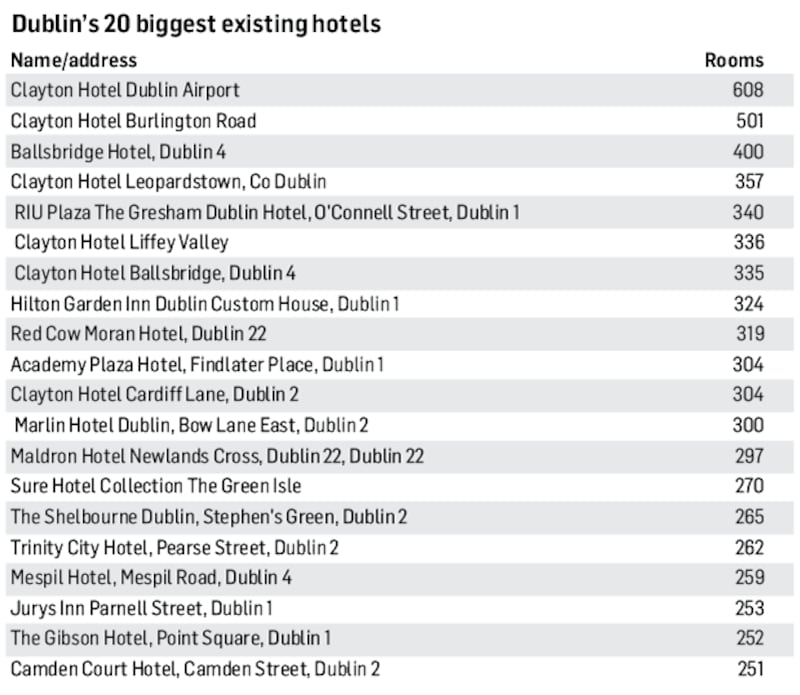
Are they all needed? Those who support the development of new hotels point to a decade in which the capital saw no meaningful increase in the number of new hotel rooms, even as visitor numbers continued to grow exponentially.
In September 2019, Fáilte Ireland pointed to the shortfall of 1,100 rooms it said the capital would experience in 2020, notwithstanding the “strong pipeline” of new accommodation which is now in the process of being delivered.
The tourism representative body was responding to a call by some members of Dublin City Council to limit the development of hotels, to “urgently protect and promote nightlife and creative culture”.
The hotel room deficit is even more pronounced if one accepts the estimated 845,815 “conference nights” Fáilte Ireland says Dublin lost between 2016 and 2019. The tourism authority believes another 193,992 conference nights will be lost this year as a result of a continuing shortfall in supply. It’s a valid consideration. Some €109 million is expected to flow from the 76,000 delegates set to attend the 150 events in Dublin in 2020.
So does Dublin have too few or too many hotels? It’s a complex question, and one for which the answer differs depending on any number of variables, only some of which are predictable.
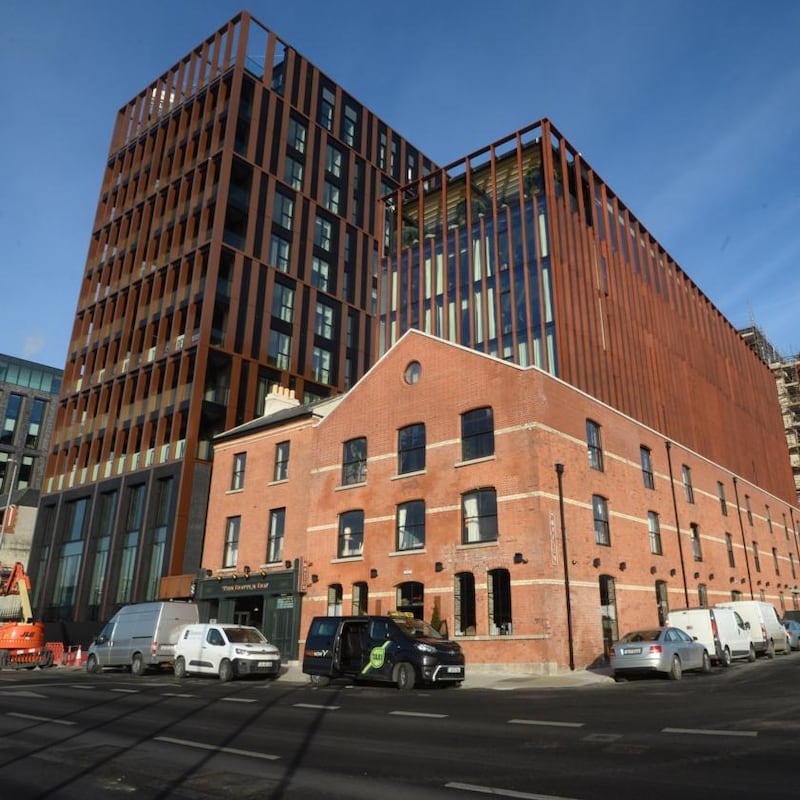
IF YOU'RE LOOKING for a useful barometer of the strength or otherwise of the Dublin hotel sector and the number of rooms required to service it, it's instructive to track the fortunes of publicly-listed hotel company Dalata.
Given its obligation to keep its shareholders informed of its activities and financial performance, Dalata’s annual reports and trading updates arguably offer the most timely and accurate snapshots of the hotel market.
In its most recent trading update, on December 18th, Dalata highlighted what it described as “tougher than anticipated market conditions” in Dublin in the second half of 2019, which resulted in a 3.2 per cent fall in RevPAR (revenue per available room) at its hotels in the 11-month period to the end of November.
Explaining that decline, the company noted that “the Dublin market continued to be impacted by the VAT increase, the additional supply of [1,000] hotel rooms and a reduction in the number of events in October and November”.
The drop in Dalata’s RevPAR is pretty much in line with the 3 per cent decline Dan O’Connor, vice-president at JLL’s hotels division estimates took place across the wider hotel market in 2019. In explaining this drop in revenues, O’Connor cites the combination of the Government’s reintroduction of the 13.5 per cent VAT rate for hotels, Brexit uncertainty, sterling weakness and an increase of hotel room supply.
While those challenges will continue, and potentially be exacerbated by an increase of 15 per cent in the current supply of 24,000 hotel rooms by the end of this year, O’Connor says there are “genuine reasons to be optimistic” for the sector.
Asked for his response to claims that Dublin is being swamped by the development of new hotels, he says: “No. New supply is needed. To support this view, at the end of this decade, despite tens of new hotels opening in the past three years [1,500 new rooms opened in 2019 alone], Dublin still boasted a higher occupancy rate than any other European capital.
“The issue is not the amount of new supply. It’s the volatile timing of its delivery to the market. Having built no new hotel rooms in Ireland in the first half of the 2010s, we then raced to catch up, with significant delivery in recent years.
“We at JLL expect this trend to be reversed in the 2020s, with the highest levels of new hotel supply expected to come on stream in the early part of the decade [2020-2022] and more muted new supply delivery thereafter.”
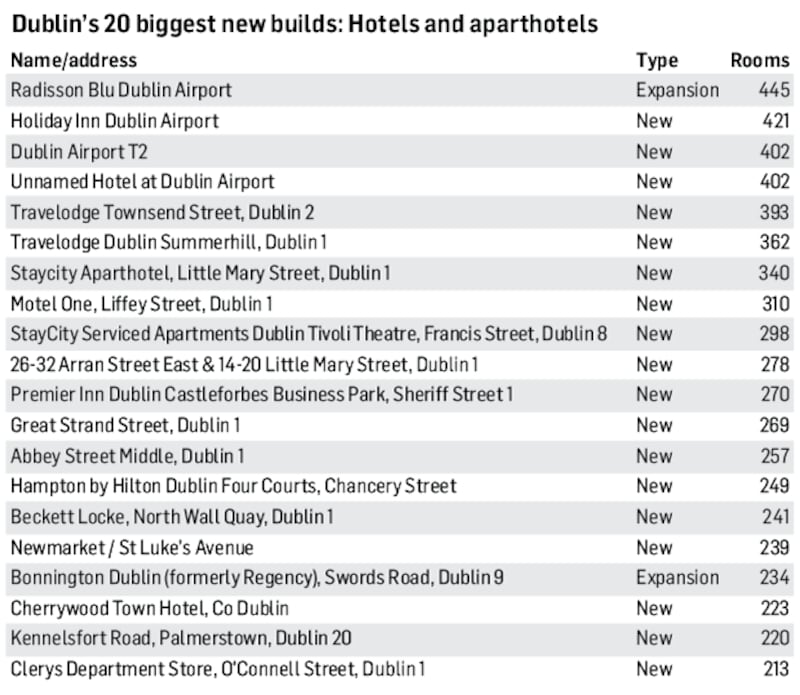
Leaving aside the present and anticipated buoyancy in visitor numbers, however, Dublin’s hotel sector remains no less vulnerable than any other city to both home-grown and international economic shocks, which could see occupancy levels and room rates plummet overnight.
While the hotel business can be highly volatile at times, the Dublin market is an attractive proposition for the medium to long-term judging by the acquisition of several of the city’s highest-profile hotels by international investors in 2019.
Included in these major deals were the €134 million sale of the Marker (which will be rebranded as Ananatara) to German investor Deka Immobolien; the €116 million sale of the Conrad Dublin to Archer Hotel Capital; the €50 million sale of Portmarnock Hotel & Golf Links to Canadian-headquartered Northland Properties; and the €40 million sale of the Central Hotel to Deutsche Finance International.
The average price across all Dublin hotel deals last year was €400,000 per room – or “per key”. The Marker set a new record of €700,000 per key.
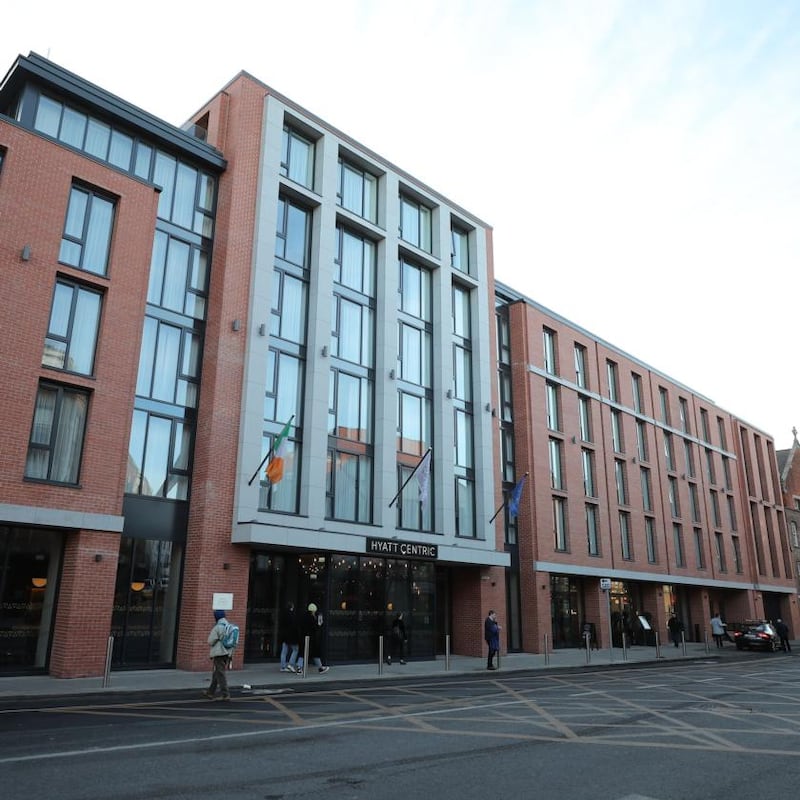
APART FROM THE EXTRAORDINARY appetite among investors for existing hotel stock, Dublin is witnessing a near unprecedented level of new hotel development.
A detailed examination of the planning files at Dublin’s four local authorities shows that a total of 100 hotels, aparthotels, or other forms of guest accommodation are either the subject of a planning application or are under development. To put that figure in perspective, an analysis of the Dublin market by JLL shows there are 250-plus hotels in operation in the city and its surrounds at present.
While the vast majority of these are long established, there have been a number of new additions in the city centre over recent months including: the 234-bedroom Hyatt Centric on Dean Street in Dublin 8; Marriott's 158-bedroom Moxy Dublin City hotel at Sackville Place, Dublin 1; and the 300-bedroom Marlin Hotel on Bow Lane East in Dublin 2.
Also open for business is the 87-bedroom Mayson at North Wall Quay in Dublin 1. The docklands hotel represents the latest addition to the near 50-strong stable of bars, hotels and restaurants operated by Paddy McKillen jnr and business partner Matt Ryan’s Press Up Entertainment Group.
McKillen and Ryan's development company, Oakmount, meanwhile is involved in the delivery of a new 213-bedroom hotel as part of its wider development of the Clerys Quarter. Located on the site of the former Clerys department store on O'Connell Street, the development will comprise a mix of offices, retail, leisure facilities, a rooftop restaurant and an as-yet-unnamed boutique hotel.
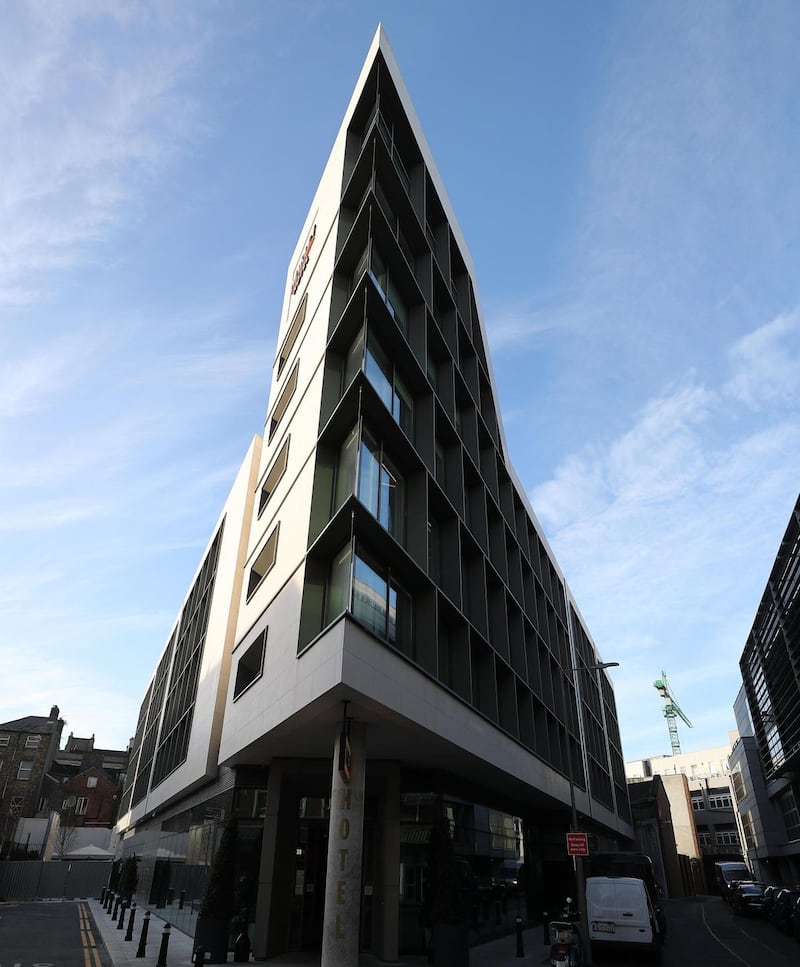
Still more high-profile hotels are due in the capital by the end of 2021: the 157-bedroom hotel Johnny Ronan’s Ronan Group Real Estate (RGRE) is incorporating into Aqua Vetro, the 23-storey office tower it is developing on Tara Street; and the 163-bedroom hotel being built on the site of the landmark Big Tree pub on Dorset Street by the Dublin Loft Company. The Dublin Loft Company, led by siblings Mark, Andrew and Kelly Cosgrave of the Cosgrave developer family, opened its first hotel, the 146-bedroom Hendrick, in Dublin’s Smithfield area in May 2019.
Another highly-anticipated hotel due in the medium term is a boutique hotel from Ashford Castle owner Red Carnation, planned for Hatch Hall on Hatch Street in Dublin 2 – which operated as a direct provision centre until 2019. Having paid more than €20 million to acquire the former Victorian university residence hall last summer, the UK-headquartered hotel operator is aiming to deliver a five-star hotel to compete with the likes of the Merrion, Shelbourne and Dublin Conrad, all located nearby.
Premier Inn, which is owned by Whitbread Plc, has secured five sites in the capital to date. In December 2019 alone, the company agreed separate deals for the development of two new hotels, one on Gloucester Street in the city's south docklands and another next to Newmarket Square in Dublin 8.
Prior to that, Premier Inn secured three sites capable of accommodating a total of 527 rooms at South Great George’s Street, Jervis Street and at Castleforbes Business Park.
LAST YEAR WAS a particularly strong one for the purchase of hotel sites in Dublin, with more than €100 million spent by international operators looking to capitalise on the city's thriving tourist economy.
But while some argue that Dublin is being overwhelmed by the development of hotels at present, it should be borne in mind that both these new arrivals and the city’s established hotel stock could be vastly and rapidly reduced – if investors decide that the lands they occupy could be put to a more profitable use. One doesn’t have to look too far back in history to find instances where some of Dublin’s highest-profile hotels faced the wrecking ball as their owners sold up to developers intent on the delivery of residential and other forms of commercial development.
The most striking example of this was when the Gallagher and Doyle families secured in excess of €700 million from developer Seán Dunne for the 400-bed Jurys and 185-bed Berkeley Court hotels in Ballsbridge, and the sale to Bernard McNamara of the 501-bedroom Burlington Hotel, the 179-bedroom Montrose Hotel in Donnybrook and the 109-bedroom Tara Towers Hotel in Booterstown.
The disposal of those five properties took place against the backdrop of a wider realignment of the then Jurys Doyle hotel group’s business, which also saw the €1.65 billion sale of the Jurys Inn chain of budget hotels to Quinlan Private.
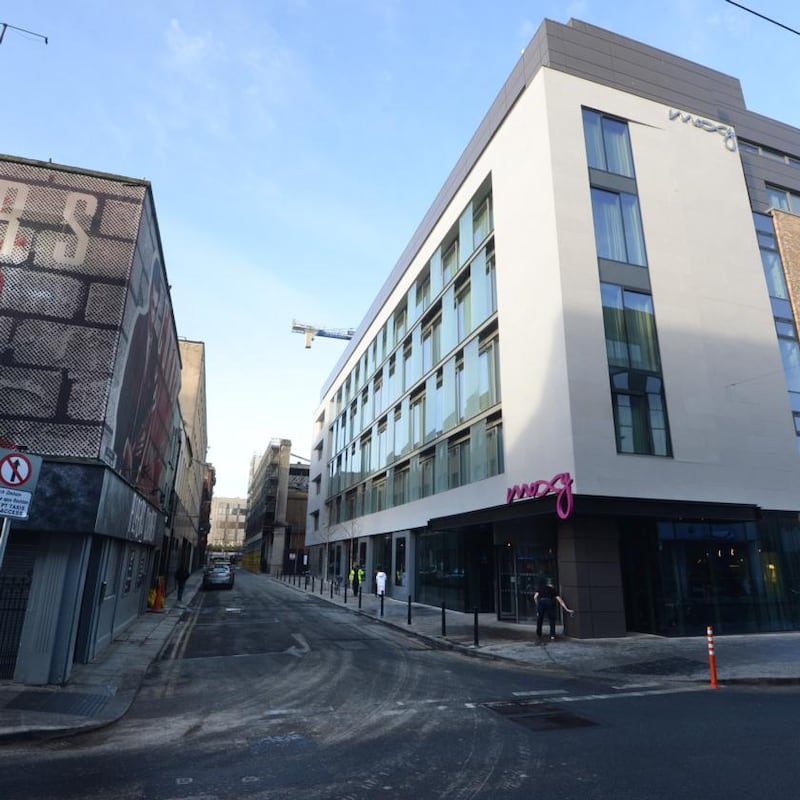
While Dunne never got to realise his own ambitions for the redevelopment of the Jurys and Berkeley Court hotel lands, the Dublin 4 site is now being transformed by former rival Joe O’Reilly’s Chartered Land into a high-end residential scheme known as Lansdowne Place.
The Berkeley Court has already been demolished and replaced by several apartment buildings, while the former Jurys trades as the Ballsbridge Hotel in advance of its own removal and redevelopment.
The Burlington Hotel, meanwhile, continues to trade successfully, having changed hands twice in the years since the crash.
Had the Irish economy not imploded shortly after developer Bernard McNamara’s original €288 million boom-era acquisition of the Dublin 4 property, both it and then adjacent headquarter premises of Axa Insurance would have been demolished and replaced as part of a €1 billion mixed-use scheme comprising offices, apartments and retail.
The Montrose Hotel, Dublin 4, didn’t make it through the crash and recovery. Following its sudden closure in 2010, the landmark property favoured by generations of American tourists was redeveloped as student accommodation.
The Tara Towers Hotel on Merrion Road was demolished last year. It is being replaced with a new hotel by the Dalata Hotel Group and a scheme of 69 apartments which the hotelier has forward sold to Ireland's largest private residential landlord, Ires Reit.

















